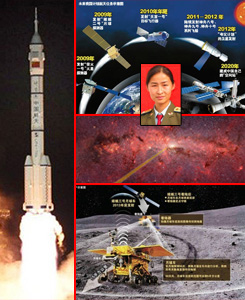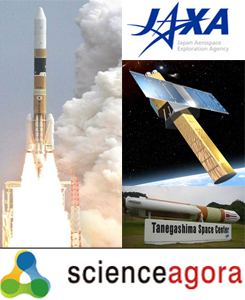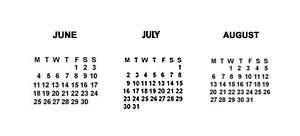China Advancing: Shenzhou 9 Launch & Chang’e 3 Moon Lander Preparations
 Steady progress by China in space development and exploration continues. The Shenzhou 9 mission to the indigenous 8.5-metric ton orbiting space station precursor, Tiangong 1, is a signal achievement in human spaceflight for the burgeoning China space program, not least because the crew of 3 includes the first female Taikonaut Liu Yang. Advanced preparations are also underway for launch of the Chang’e-3 robotic lander mission to the surface of the Moon in 2013. Barring any early attempt from GLXP contenders, this is likely to be the first spacecraft to make a soft, controlled landing on the lunar surface since Luna 24 on August 7, 1976. There are growing indications that China is opening up to international collaboration. The International Lunar Observatory Association is preparing a proposal for Milky Way Galaxy, astronomical imaging with the lander-mounted telescope. Chang’e-4 is a second lander / rover mission that, if Chang’e-3 is successful at Sinus Iridum (44.1° N), could break new ground at the Moon South Pole. Chang’e-5 is planned for 2017 as a sample return mission. (Image Credit: CNSA, ILOA)
Steady progress by China in space development and exploration continues. The Shenzhou 9 mission to the indigenous 8.5-metric ton orbiting space station precursor, Tiangong 1, is a signal achievement in human spaceflight for the burgeoning China space program, not least because the crew of 3 includes the first female Taikonaut Liu Yang. Advanced preparations are also underway for launch of the Chang’e-3 robotic lander mission to the surface of the Moon in 2013. Barring any early attempt from GLXP contenders, this is likely to be the first spacecraft to make a soft, controlled landing on the lunar surface since Luna 24 on August 7, 1976. There are growing indications that China is opening up to international collaboration. The International Lunar Observatory Association is preparing a proposal for Milky Way Galaxy, astronomical imaging with the lander-mounted telescope. Chang’e-4 is a second lander / rover mission that, if Chang’e-3 is successful at Sinus Iridum (44.1° N), could break new ground at the Moon South Pole. Chang’e-5 is planned for 2017 as a sample return mission. (Image Credit: CNSA, ILOA)
Japan Developments in 21st Century Space Endeavors
 Space agency JAXA plans to launch the next H-2A/HTV NLT March 2013, having successfully conducted its first commercial payload launch of 1 South Korea and 3 Japan satellites on May 18 from Tanegashima Space Center. The next H-2B/HTV launch to provide the International Space Station with food and other supplies is scheduled for July 21, with two more launches for HTV technical trials scheduled in 2013. JAXA also plans to launch ASTRO-H in 2014 using an H-2A rocket — its 6th X-ray observation satellite designed to explore the structure and evolution of the universe. Japan was an early innovator in this field and continues to lead the world in X-ray astronomy satellite technology. Upcoming events in Tokyo include the International Lunar Observatory Association (ILOA) Galaxy Forum, which is tentatively scheduled for September, and Science Agora 2012, which will be held in November. The Galaxy Forum advances 21st Century Education worldwide to provide greater global awareness, capabilities and action in Galaxy science, exploration and enterprise. Under the theme of “Discovering the Science in Your Life,” Science Agora 2012 fosters science communication, enabling interaction between scientists and the rest of society. (Image Credit: AFP / JIJI, Akihiro Ikeshita / JAXA)
Space agency JAXA plans to launch the next H-2A/HTV NLT March 2013, having successfully conducted its first commercial payload launch of 1 South Korea and 3 Japan satellites on May 18 from Tanegashima Space Center. The next H-2B/HTV launch to provide the International Space Station with food and other supplies is scheduled for July 21, with two more launches for HTV technical trials scheduled in 2013. JAXA also plans to launch ASTRO-H in 2014 using an H-2A rocket — its 6th X-ray observation satellite designed to explore the structure and evolution of the universe. Japan was an early innovator in this field and continues to lead the world in X-ray astronomy satellite technology. Upcoming events in Tokyo include the International Lunar Observatory Association (ILOA) Galaxy Forum, which is tentatively scheduled for September, and Science Agora 2012, which will be held in November. The Galaxy Forum advances 21st Century Education worldwide to provide greater global awareness, capabilities and action in Galaxy science, exploration and enterprise. Under the theme of “Discovering the Science in Your Life,” Science Agora 2012 fosters science communication, enabling interaction between scientists and the rest of society. (Image Credit: AFP / JIJI, Akihiro Ikeshita / JAXA)

![]() = All times for terrestrial events in local time unless noted.
= All times for terrestrial events in local time unless noted.
![]() = All times for international terrestrial events in local time unless noted.
= All times for international terrestrial events in local time unless noted.
![]() = All times for space events, and…
= All times for space events, and…
![]() = All times for international space / astro events in Hawaii Standard Time unless noted. Add 10 hours to obtain UT (‘Universal Time;’ Greenwich, England).
= All times for international space / astro events in Hawaii Standard Time unless noted. Add 10 hours to obtain UT (‘Universal Time;’ Greenwich, England).
Weekly Planet Watch – Evening Planets: Mercury (WNW), Mars (SW), Saturn (SSW). Morning Planets: Venus (ENE), Jupiter (ENE).
MONDAY
![]() Jun 18 — CNSA, Launch Long March / Shenzhou 9, Jiuquan, China: Shenzhou 9 should be in orbit if June 16 launch was successful and on time.
Jun 18 — CNSA, Launch Long March / Shenzhou 9, Jiuquan, China: Shenzhou 9 should be in orbit if June 16 launch was successful and on time.
![]() Jun 18 — International Space Station, LEO: Expedition 31 crew continue to use the Alpha Magnetic Spectrometer-02, the solar arrays that power the space station, to conduct high energy physics research, measure cosmic radiation and search for dark matter and anti-matter.
Jun 18 — International Space Station, LEO: Expedition 31 crew continue to use the Alpha Magnetic Spectrometer-02, the solar arrays that power the space station, to conduct high energy physics research, measure cosmic radiation and search for dark matter and anti-matter.
![]() Jun 18 — Lunar Reconnaissance Orbiter (LRO), Lunar Orbit: NASA LRO functioning nominally in its 50±15 km near-circular orbit as it makes digital elevation and surface maps that will be fundamental references for future human exploration.
Jun 18 — Lunar Reconnaissance Orbiter (LRO), Lunar Orbit: NASA LRO functioning nominally in its 50±15 km near-circular orbit as it makes digital elevation and surface maps that will be fundamental references for future human exploration.
![]() Jun 18 — Mars Rover Opportunity, Red Planet: Opportunity is investigating light-toned veins around the north end of Cape York on the rim of Endeavour Crater.
Jun 18 — Mars Rover Opportunity, Red Planet: Opportunity is investigating light-toned veins around the north end of Cape York on the rim of Endeavour Crater.
![]() Jun 18 — Jupiter Juno Mission, Jupiter Trajectory: Juno spacecraft has 4 instruments turned on: the Magnetometer experiment (FGM & ASC), JEDI, MWR and Waves; Tests were recently performed in preparation for upcoming deep space maneuvers.
Jun 18 — Jupiter Juno Mission, Jupiter Trajectory: Juno spacecraft has 4 instruments turned on: the Magnetometer experiment (FGM & ASC), JEDI, MWR and Waves; Tests were recently performed in preparation for upcoming deep space maneuvers.
![]() Jun 18 — ULA, Launch Atlas 5 / NROL 38, Vandenberg AFB CA: A ULA Atlas 5 rocket set to launch a classified spacecraft payload for the USA National Reconnaissance Office; NET 2:26.
Jun 18 — ULA, Launch Atlas 5 / NROL 38, Vandenberg AFB CA: A ULA Atlas 5 rocket set to launch a classified spacecraft payload for the USA National Reconnaissance Office; NET 2:26.
![]() Jun 18 — Chashama, New York, NY: ‘Chashama Gala 2012;’ organization responsible for the ‘Flight 18‘ event.
Jun 18 — Chashama, New York, NY: ‘Chashama Gala 2012;’ organization responsible for the ‘Flight 18‘ event.
![]() Jun 18-21 — Center for Astrophysics and Space Astronomy, Kaua`i HI: ‘UV Astronomy: HST and Beyond.‘
Jun 18-21 — Center for Astrophysics and Space Astronomy, Kaua`i HI: ‘UV Astronomy: HST and Beyond.‘
![]() Jun 18-22 — Ames Research Center, Moffett Field CA: ‘2012 Lunar Extreme Program and Workshop.’
Jun 18-22 — Ames Research Center, Moffett Field CA: ‘2012 Lunar Extreme Program and Workshop.’
![]() Jun 18-22 — Space Foundation Discovery Institute, Colorado Springs CO: ‘Space Across the Curriculum: Meteorology and Space Weather.’
Jun 18-22 — Space Foundation Discovery Institute, Colorado Springs CO: ‘Space Across the Curriculum: Meteorology and Space Weather.’
![]() Jun 18-22 — Jet Propulsion Laboratory, Pasadena CA: ‘24th Annual Planetary Science Summer School: Session 1.’
Jun 18-22 — Jet Propulsion Laboratory, Pasadena CA: ‘24th Annual Planetary Science Summer School: Session 1.’
![]() Jun 18 – Jul 26 — NASA Explorer Schools, Various NASA centers: ‘NASA Explorer Schools Summer Workshop;’ workshops to include ‘Extreme Green’ at the Glenn Research Center in Cleveland, OH; ‘Airborne Research Experience’ at Dryden Flight Research Center in Edwards, CA; ‘There is More to Light than Meets the Eye’ at the Goddard Space Flight Center in Greenbelt, MD; and ‘Atmospheric Science’ at Wallops Island, VA.
Jun 18 – Jul 26 — NASA Explorer Schools, Various NASA centers: ‘NASA Explorer Schools Summer Workshop;’ workshops to include ‘Extreme Green’ at the Glenn Research Center in Cleveland, OH; ‘Airborne Research Experience’ at Dryden Flight Research Center in Edwards, CA; ‘There is More to Light than Meets the Eye’ at the Goddard Space Flight Center in Greenbelt, MD; and ‘Atmospheric Science’ at Wallops Island, VA.
Continued from…
![]() Jun 11-21 — NASA Extreme Environment Mission Operations, Key Largo, FL: ‘NEEMO 16 Asteroid Extravehicular Activity Techniques Training.’
Jun 11-21 — NASA Extreme Environment Mission Operations, Key Largo, FL: ‘NEEMO 16 Asteroid Extravehicular Activity Techniques Training.’
![]() Jun 16-22 — National Space Grant Program, Colorado Space Grant Consortium, Wallops Flight Facility, et al, Wallops Flight Facility VA: ‘RockOn! 2012: The Next How-To Workshop.’
Jun 16-22 — National Space Grant Program, Colorado Space Grant Consortium, Wallops Flight Facility, et al, Wallops Flight Facility VA: ‘RockOn! 2012: The Next How-To Workshop.’
![]() Jun 17-22 — National Science Foundation Division of Atmospheric Sciences, Snowmass CO: ‘Geospace Environmental Modeling Summer Workshop.’
Jun 17-22 — National Science Foundation Division of Atmospheric Sciences, Snowmass CO: ‘Geospace Environmental Modeling Summer Workshop.’
![]() Jun 17 – Jul 1 — Aspen Center for Physics, Aspen CO: ‘The Evolution of Massive Stars and Progenitors of Gamma-Ray Bursts.’
Jun 17 – Jul 1 — Aspen Center for Physics, Aspen CO: ‘The Evolution of Massive Stars and Progenitors of Gamma-Ray Bursts.’
TUESDAY
![]() Jun 19 — International Launch Services, Launch Proton / SES 5, Baikonur Cosmodrome, Kazakhstan: An ILS Proton rocket with a Breeze M upper stage set to deploy the SES 5 satellite which will provide communications services over Africa, Europe and the Middle East; 6:24.
Jun 19 — International Launch Services, Launch Proton / SES 5, Baikonur Cosmodrome, Kazakhstan: An ILS Proton rocket with a Breeze M upper stage set to deploy the SES 5 satellite which will provide communications services over Africa, Europe and the Middle East; 6:24.
![]() Jun 19 — Glenn Research Center, Cleveland OH: ‘NASA HUBZone Industry Day.’
Jun 19 — Glenn Research Center, Cleveland OH: ‘NASA HUBZone Industry Day.’
![]() Jun 19 — Telespazio Vega, XCOR Aerospace, Excalibur Almaz, Logica, London, United Kingdom: ‘3rd European Space Tourism Conference.’
Jun 19 — Telespazio Vega, XCOR Aerospace, Excalibur Almaz, Logica, London, United Kingdom: ‘3rd European Space Tourism Conference.’
WEDNESDAY
![]() Jun 20 — The SETI Institute, Mountain View CA: Colloquium Series Lecture: ‘Fast Molecular Adaptations to Environmental Fluctuations A Recipe for Long-Term Survival of Life in the Extremes,’ Oana Marcu.
Jun 20 — The SETI Institute, Mountain View CA: Colloquium Series Lecture: ‘Fast Molecular Adaptations to Environmental Fluctuations A Recipe for Long-Term Survival of Life in the Extremes,’ Oana Marcu.
![]() Jun 20 — American Institute of Aeronautics and Astronautics – San Francisco, Mountain View CA: ‘AIAA-SF Honors and Awards Banquet,’ featuring a talk by Seth Shostak of the SETI Institute on ‘Looking for Life Beyond Earth.’
Jun 20 — American Institute of Aeronautics and Astronautics – San Francisco, Mountain View CA: ‘AIAA-SF Honors and Awards Banquet,’ featuring a talk by Seth Shostak of the SETI Institute on ‘Looking for Life Beyond Earth.’
![]() Jun 20 — U.S. Senate Subcommittee on Science and Space, Washington, D.C.: ‘Senate Hearing: Risks, Opportunities, and Oversight of Commercial Space.’
Jun 20 — U.S. Senate Subcommittee on Science and Space, Washington, D.C.: ‘Senate Hearing: Risks, Opportunities, and Oversight of Commercial Space.’
![]() Jun 20-21, 26-27 — NASA, Kentucky Southeast-South Central Education Cooperative, Richmond; Corbin KY: ‘NASA Conference: Educate to Innovate.’
Jun 20-21, 26-27 — NASA, Kentucky Southeast-South Central Education Cooperative, Richmond; Corbin KY: ‘NASA Conference: Educate to Innovate.’
![]() Jun 20 — Summer Solstice: Days are longer and nights shortest (opposite in southern hemisphere) as the Sun, traveling along the ecliptic, reaches a point farthest north of the celestial equator; 13:07.
Jun 20 — Summer Solstice: Days are longer and nights shortest (opposite in southern hemisphere) as the Sun, traveling along the ecliptic, reaches a point farthest north of the celestial equator; 13:07.
![]() Jun 20 — Venus: 3.0° NW of Aldebaran; 05:00.
Jun 20 — Venus: 3.0° NW of Aldebaran; 05:00.
![]() Jun 20 — Mercury: 5.1° SSW of Pollux; 11:00.
Jun 20 — Mercury: 5.1° SSW of Pollux; 11:00.
![]() Jun 20 — Asteroid 2012 LF4: Near-Earth Flyby (0.0352 AU).
Jun 20 — Asteroid 2012 LF4: Near-Earth Flyby (0.0352 AU).
THURSDAY
![]() Jun 21-22 — Jet Propulsion Laboratory, Pasadena CA: ‘The von Karman Lecture Series: Melting Snows – The Threatened Lifeblood of the Western US.’
Jun 21-22 — Jet Propulsion Laboratory, Pasadena CA: ‘The von Karman Lecture Series: Melting Snows – The Threatened Lifeblood of the Western US.’
![]() Jun 21 — Asteroid 308242 (2005 GO12): Near-Earth Flyby (0.044 AU).
Jun 21 — Asteroid 308242 (2005 GO12): Near-Earth Flyby (0.044 AU).
![]() Jun 21 — Moon: 10.6° SSW of Pollux; 04:00.
Jun 21 — Moon: 10.6° SSW of Pollux; 04:00.
![]() Jun 21 — Moon: 5.5° S of Mercury; 07:00.
Jun 21 — Moon: 5.5° S of Mercury; 07:00.
![]() Jun 21 — Asteroid 2005 GO21: Near-Earth Flyby (0.0440 AU).
Jun 21 — Asteroid 2005 GO21: Near-Earth Flyby (0.0440 AU).
FRIDAY
![]() Jun 22-24 — The SETI Institute, Santa Clara CA: ‘SETIcon 2.’
Jun 22-24 — The SETI Institute, Santa Clara CA: ‘SETIcon 2.’
![]() Jun 22 — Moon: 6.0° S of Beehive Cluster; 09:00.
Jun 22 — Moon: 6.0° S of Beehive Cluster; 09:00.
![]() Jun 22 — Asteroid 2012 LG4: Near-Earth Flyby (0.0533 AU).
Jun 22 — Asteroid 2012 LG4: Near-Earth Flyby (0.0533 AU).
SATURDAY
![]() Jun 23 — SpaceUp, Austin TX: ‘SpaceUp 2012: Austin.’
Jun 23 — SpaceUp, Austin TX: ‘SpaceUp 2012: Austin.’
![]() Jun 23 — Jet Propulsion Laboratory – Educator Resource Center, Pomona CA: ‘Educator Workshop: Lunar and Meteorite Sample Certification Program.’
Jun 23 — Jet Propulsion Laboratory – Educator Resource Center, Pomona CA: ‘Educator Workshop: Lunar and Meteorite Sample Certification Program.’
![]() Jun 23 — Venus: 10.6° SE of the Pleiades; 22:00.
Jun 23 — Venus: 10.6° SE of the Pleiades; 22:00.
![]() Jun 23 — Asteroid 2012 LU: Near-Earth Flyby (0.0148 AU).
Jun 23 — Asteroid 2012 LU: Near-Earth Flyby (0.0148 AU).
SUNDAY
![]() Jun 24-29 — Center for Planetary Science – International School of Planetary Sciences, Kobe, Japan: ‘CPS 9th International School of Planetary Sciences: Across the Earth Into Exoplanets.’
Jun 24-29 — Center for Planetary Science – International School of Planetary Sciences, Kobe, Japan: ‘CPS 9th International School of Planetary Sciences: Across the Earth Into Exoplanets.’
![]() Jun 24 — Moon: 5.7° SSW of Regulus; 01:00.
Jun 24 — Moon: 5.7° SSW of Regulus; 01:00.